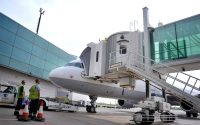Lisbon is home to Portugal’s main airport, Europe’s biggest hub to Brazil, and one of the most important airports serving Africa. The city’s geographical location, between South America and Asia and North America and Africa, makes it an ideal connecting point between these continents. And, being the most Western country in Europe, by the Atlantic Ocean, Portugal, has always had cultural interchange in its DNA – it was in the 15th century that the Portuguese began making their global discoveries, including South America, Africa and Asia, so it comes as no surprise that Lisbon is so multicultural and diverse, which reflects on Lisbon Airport’s traffic mix.
Lisbon Airport handled more than 14 million passengers in 2010, which represents a growth of almost 50 per cent in the last decade. In 2011, and despite the gloomy economic outlook, its performance has been robust and in the nine months to September it registered a consolidated growth of 6.1 per cent, an additional 600,000 passengers.
Traffic Statistics: Lisbon Airport
| Year | Passengers (millions) |
| 2000 | 9.4 |
| 2001 | 9.4 |
| 2002 | 9.4 |
| 2003 | 9.6 |
| 2004 | 10.7 |
| 2005 | 11.2 |
| 2006 | 12.3 |
| 2007 | 13.4 |
| 2008 | 13.6 |
| 2009 | 13.3 |
| 2010 | 14 |
 Lisbon Airport is home to two Portuguese airlines, TAP Portugal and SATA Internacional and will be easyJet’s 20th European base from the beginning of 2012. From Lisbon, TAP Portugal, a Star Alliance member, currently serves 75 destinations, easyJet 16 destinations and SATA 9 destinations. Lisbon Airport is also served by some other 34 scheduled airlines from Europe, North America and Africa to more than 100 destinations worldwide.
Lisbon Airport is home to two Portuguese airlines, TAP Portugal and SATA Internacional and will be easyJet’s 20th European base from the beginning of 2012. From Lisbon, TAP Portugal, a Star Alliance member, currently serves 75 destinations, easyJet 16 destinations and SATA 9 destinations. Lisbon Airport is also served by some other 34 scheduled airlines from Europe, North America and Africa to more than 100 destinations worldwide.
In 2011 it is estimated that the traffic to/from Brazil will reaches 1.6 million passengers as it is currently growing at a rate of 8.4 per cent year-on-year, strengthening Lisbon’s position as the main European hub to Brazil and the biggest European airport serving South America among the Star Alliance hubs. In fact this month Lisbon Airport was the largest facility outside South America, in terms of seat capacity and number of cities served in Brazil.
|
INTERNATIONAL SCHEDULED FLIGHTS TO BRAZIL (one-way weekly seats) |
|||
|
RANK |
AIRPORT |
WEEKLY SEATS |
DESTINATIONS |
|
1 |
Lisbon Airport (LIS) |
18,265 |
10 |
|
2 |
Miami International (MIA) |
16,767 |
6 |
|
3 |
Paris Charles De Gaulle (CDG) |
10,167 |
2 |
|
4 |
Madrid Barajas (MAD) |
10,150 |
4 |
|
5 |
New York JFK (JFK) |
8,840 |
2 |
Source: IATA, SRS Analyser for September 2011
In the last five years, Lisbon Airport has invested heavily in enhancing its facility, boosting new retail and commercial areas, check-in desks, new boarding gates with air-bridges, a new cargo terminal, a new passengers terminal (targeted to provide quick aircraft turnarounds), as well as new taxiways and apron space. The airport has now two terminals, 106 check-in desks, 47 boarding gates, faster border control, 20,000 sq m of retail and the capacity to handle 150,000 tons of cargo. This development plan will be completed in the first semester of 2012 with further commercial and lounge areas, enhanced transfer facilities and services and the opening of a new hotel within the airport perimeter. The recent expansion has certainly increased passenger comfort, the efficiency of airline operations as well as the overall capacity at Lisbon Airport from 34 to 40 aircraft movements an hour, while passenger capacity has grown from 2,800 to 4,200 passengers per hour.
This development plan will be completed in the first semester of 2012 with further commercial and lounge areas, enhanced transfer facilities and services and the opening of a new hotel within the airport perimeter. The recent expansion has certainly increased passenger comfort, the efficiency of airline operations as well as the overall capacity at Lisbon Airport from 34 to 40 aircraft movements an hour, while passenger capacity has grown from 2,800 to 4,200 passengers per hour.
This year has been one of Lisbon Airport’s best years for network development with a mix of new routes and increased frequencies on existing services. This has supported the development of Lisbon as a popular year-round destination, but also the increasing connectivity that Lisbon Airport now provides into South America and Africa. Already this year, the airport has opened two new routes in Europe, one in North America, one in South America and two in Africa and has seen frequency increases on ten others.
Europe is by far the biggest market served from Lisbon Airport and represents almost 80 per cent of its total traffic and was where the main growth has been this year. Athens and Vienna are new destinations this year, both served five times weekly by TAP Portugal, and the airline has also started flights to some cities already served by other airlines; namely Manchester and Bordeaux with six weekly flights and Dusseldorf with five weekly rotations. Dutch carrier Transavia also joined TAP and KLM on the Amsterdam route with a daily frequency and also revealed it will start flights to Eindhoven from February 2012, initially with four flights per week.
In 2010 North America represented just 2.6 per cent of Lisbon Airport’s traffic but this market has been growing around 20 per cent in the current calendar year. This growth can be largely attributed to the launch of TAP Portugal’s five times weekly link to Miami. Continental Airlines has also introduced three additional flights to Newark (now ten a week),while US Airways’ started its seasonal summer Philadelphia daily flight one month earlier than in 2010. In terms of new frequencies Air Transat also started scheduled flights to Toronto, three times weekly and to Montreal once weekly. There are currently 47 weekly flights to North American serving six destinations.
The African market represented 7.1 per cent of Lisbon Airport’s total traffic, around one million passengers in 2010. This year TAP Portugal has added a four times weekly link to Accra in Ghana and a three times weekly service to Bamako in Mali, expanding its network to 15 destinations across the continent, served by 90 weekly flights. TAP Portugal also opened a twice weekly link to São Vicente in Cape Verde Islands, a destination already served by TACV Airlines.
However, it is South America that remains a key strategic market for Lisbon Airport, representing 10 per cent of its total traffic, recording just over 1.4 million passengers and a growth of 21.9 per cent in 2010. This year the market is growing 8.4 per cent induced by the increase from 65 to 72 weekly flights as TAP Portugal has added a five times weekly service to Porto Alegre in Brazil, one of elevn destinations now served across South America.
There are two clear geographical areas currently missing from the Lisbon Airport route map – Asia and the Middle East. The airport believes there is a huge potential to start flights to these two markets in the future as more than 200,000 of its existing passengers begin or end their journeys in these areas. Lisbon actually offers perhaps the most direct routing between Asia and South America and the airport’s executives are working to add a link in the coming years with Shanghai, Seoul Incheon, Hong Kong or Tokyo the most likely destinations.
|
TOP FIVE CITIES IN ASIA FROM LISBON (bi-directional O&D passengers) |
||
|
RANK |
DESTINATION CITY |
ESTIMATED O&D PASSENGERS |
|
1 |
Hong Kong |
21,500 |
|
2 |
Shanghai |
21,000 |
|
3 |
Seoul |
20,500 |
|
4 |
Tokyo |
15,000 |
|
5 |
Beijing |
11,000 |
Source: O&D passengers - Sabre ADI, last 12 months until July 2011 Looking ahead, Lisbon Airport’s main objective when it comes to route development is to consolidate its position in Europe, strength its South American potential, increase its connectivity to Asia and increase its natural presence in Africa, as well as to improve the possible connections beyond North America. Its main target markets are understood to include Johannesburg, Cairo, Lagos, Nairobi and Addis Ababa in Africa; Shanghai, Hong Kong, Seoul, Tokyo, Beijing, Singapore, Bangkok, Delhi and Kuala Lumpur in Asia; Glasgow, Riga, Hanover, Nantes, St Petersburg and Sofia in Europe; Beirut, Tel Aviv, Abu Dhabi, Dubai and Doha in the Middle East; Chicago and Washington in North America and Bogota, Lima and Santiago de Chile in South America.
Looking ahead, Lisbon Airport’s main objective when it comes to route development is to consolidate its position in Europe, strength its South American potential, increase its connectivity to Asia and increase its natural presence in Africa, as well as to improve the possible connections beyond North America. Its main target markets are understood to include Johannesburg, Cairo, Lagos, Nairobi and Addis Ababa in Africa; Shanghai, Hong Kong, Seoul, Tokyo, Beijing, Singapore, Bangkok, Delhi and Kuala Lumpur in Asia; Glasgow, Riga, Hanover, Nantes, St Petersburg and Sofia in Europe; Beirut, Tel Aviv, Abu Dhabi, Dubai and Doha in the Middle East; Chicago and Washington in North America and Bogota, Lima and Santiago de Chile in South America.





